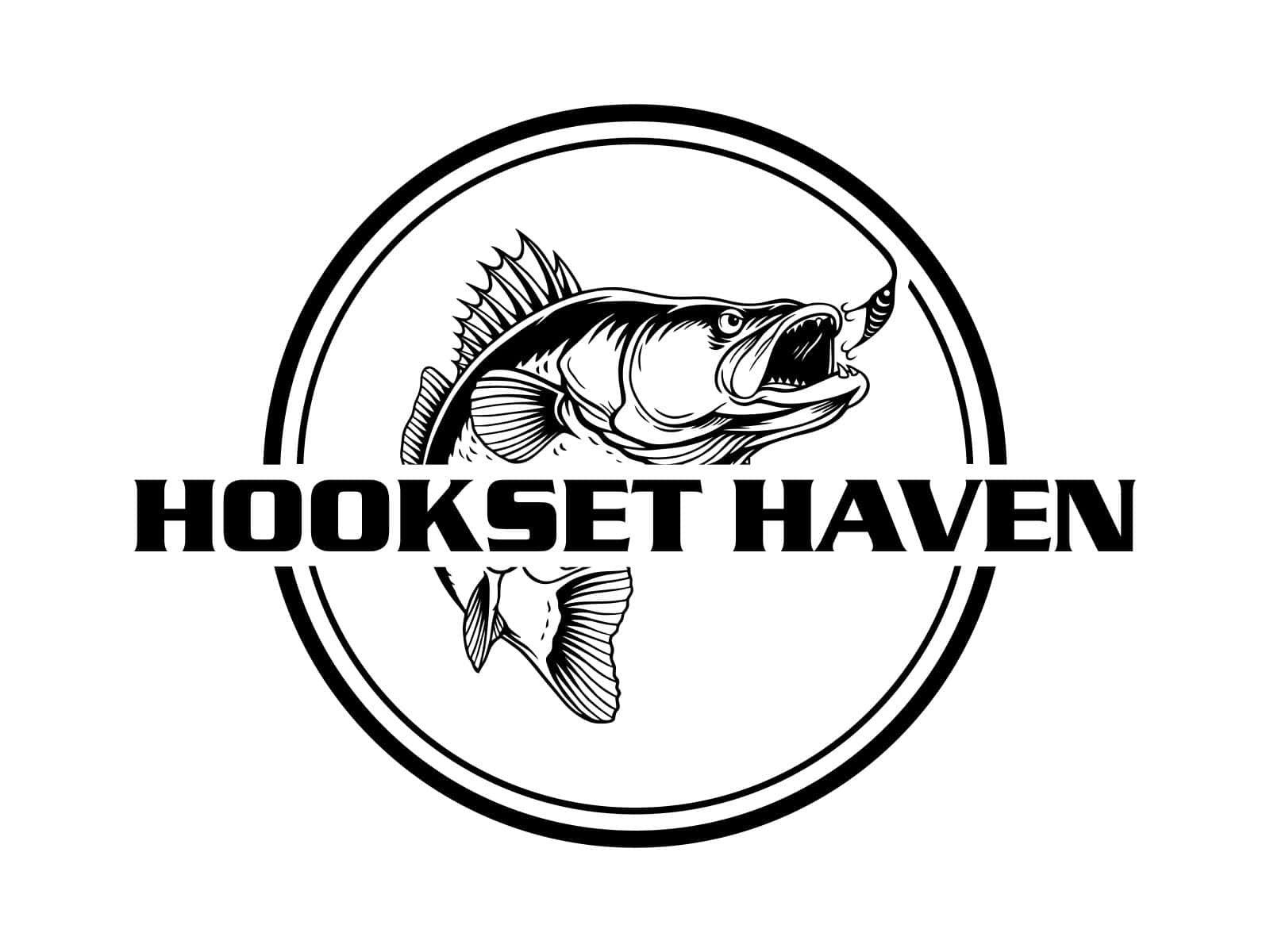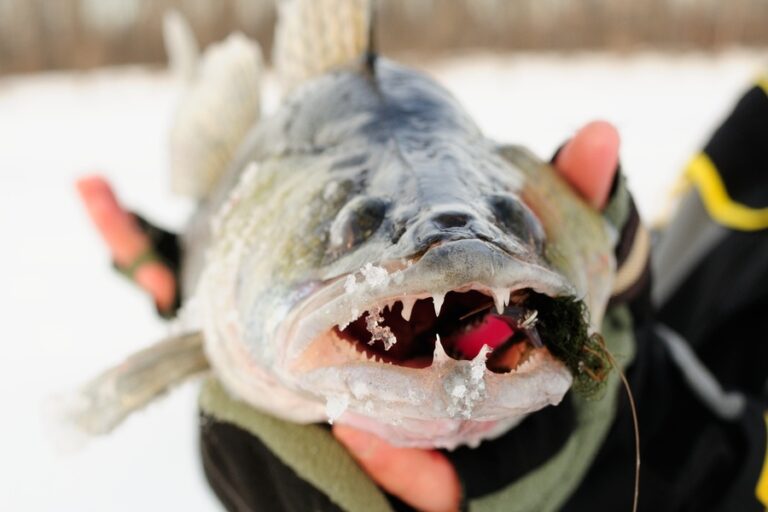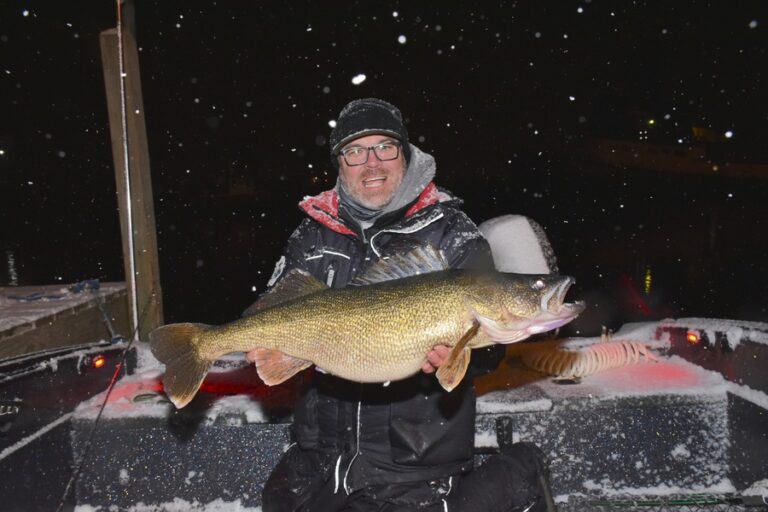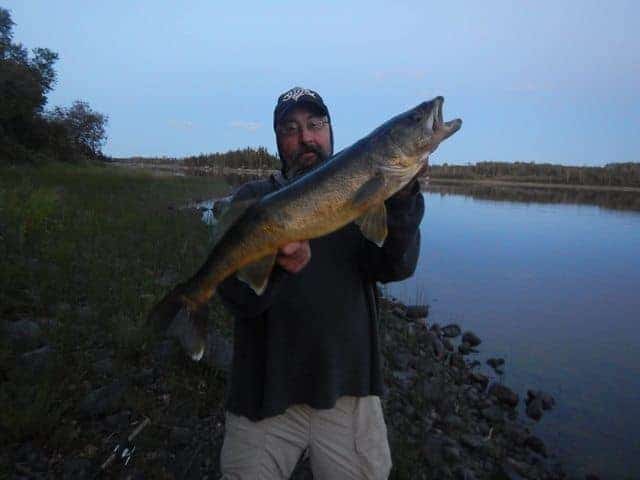Where to Catch Daytime Walleye in Lakes (Complete Guide)
Knowing where to find walleyes in a large lake during the day can seem daunting.
During the day in lakes, walleye normally stay in deeper waters where it’s cooler and darker, especially near underwater structures like rocks and logs. Fish in depths of 15-30 feet, close to transition zones where shallow water meets the deep.
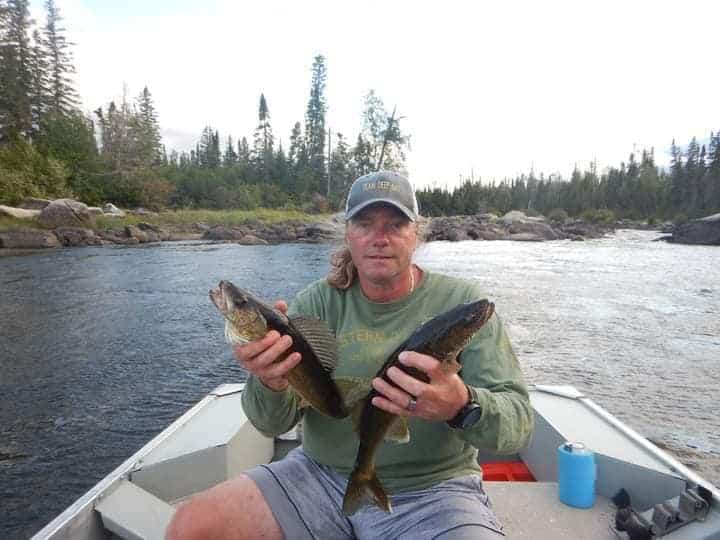
Table of Contents
Where to Catch Daytime Walleye in Lakes
Walleye behave differently during the day compared to nighttime. In bright sunlight, they prefer deeper, cooler waters, especially if the water is clear. Murky waters may see them closer to the surface, as they feel more hidden. Temperature plays a role, with walleye seeking just-right conditions.
Their location also depends on where their prey is; they’ll follow smaller fish, their primary food, regardless of the time of day. In essence, daytime walleye movements center around seeking comfort, safety, and food.
Some Cool Testing: Walleye Stomach Contents
I enlisted the help of 4 walleye fishing guides operating out of Minnesota, Manitoba, Ontario, and Lake Erie to examine the stomach contents of all the walleye their boats kept over two weeks in July. Any baitfish identifiable, we assume was eaten within the last 5 hours. Anything that was mush or simply unidentifiable, we assume was eaten more than 5 hours earlier. All walleye were caught in the morning from sunrise until around mid-morning.
A total of 175 baitfish were identified from stomach contents. The baitfish were as follows:
- Open Water/Deep Water Dominant-Baitfish: Alewives, ciscos, & smelt
- Shallow-Water/Nearshore Dominant-Baitfish: Perch and bluegill
Analysis:
Out of the total partially digested baitfish examined that were still identifiable, meaning they had been eaten within the last 5 hours, 62.86% were nearshore baitfish (perch & bluegill) whereas only 37.14% were open water forage (ciscos, smelt, or alewives).
From this sample, it appears that walleyes have preference for shallow nearshore-baitfish at night and before sunset over open deep water-baitfish during these two weeks in July across these 4 locations (again Minnesota, Manitoba, Lake Erie, and Ontario. Stomach contents of walleye caught did show that walleye feed closer to shore at night than further away from shore.
Click here to learn where to catch walleye. Click here to learn where to catch nighttime walleye in lakes.
Seasonal Variations: Where to Find Walleyes
Spring
On sunny spring days, fish in shallow areas. After the cold winter, walleyes are ready for some warmth. They like to hang out in shallower areas, especially near where streams or rivers flow into the lake because the moving water brings in warmer water and nutrients. Rock and gravel are the top choices for walleyes in spring. Sandy bottoms can also be a secondary choice in some lakes.
Check out sandbars as well. As walleyes become more active, they’ll swim around looking for food. Look for depths from 5-20 feet during the daytime. This migration takes them closer to the shorelines during the day, where they can find smaller fish and insects. Soft jerkbaits like flukes and live shiners are a great spring option.
Recommended Baits:
- Rapala Original Floating Minnow
- Size: F07 (2-3/4 inch)
- Color: Silver or gold
- Where: Shallow waters near spawning areas.
- Northland Fishing Tackle Fire-Ball Jig
- Size: 1/4 oz
- Color: Parrot or UV Firetiger
- Where: Near rocky or gravel bottoms.
- Storm Hot ‘N Tot MadFlash
- Size: 2 inches
- Color: Chrome Yellow Perch or Chrome Blue
- Where: Shallow structures or transitions.
- Berkley PowerBait Power Minnow
- Size: 3 inches
- Color: Black Shad
- Where: Near submerged vegetation or structures.
- Strike King Walleye Elite Banana Shad
- Size: 5 inches
- Color: Sexy Shad
- Where: Shallow to mid-depth transition areas.
Summer
In the heat of summer, walleyes prefer cooler spots. They’ll be deeper in the water, often near underwater structures like rock piles, sunken islands, or deep weed edges where it’s cooler and they can hide from the sun. Check out features in 20-35 feet of water during the heat of the day. Look for silty or muddy bottoms near rock piles.
Early mornings and late afternoons will be your best times to fish. It’s a huge bonus if you can also find large schools of bait like shad or perch. You’ll find white bass and walleye chasing these schools down deep during the daytime. I have caught quite a few nice white bass while targeting daytime walleye in summer as they are hunting the same food.
Recommended Baits:
- Reef Runner Deep Diver
- Size: 4-3/4 inches
- Color: Purple Tiger or Firetiger
- Where: Deep waters or around submerged structures.
- Rapala Shad Rap
- Size: SR07 (2-3/4 inch)
- Color: Hot Mustard Muddler or Blue
- Where: Mid-depth structures.
- Berkley Flicker Shad
- Size: 2 inches
- Color: Black Gold Sunset
- Where: Open water or edges of weed beds.
- Erie Dearie Original Spinner
- Size: 3/8 oz
- Color: Green or gold
- Where: Deep waters or transition areas.
- Salmo Hornet
- Size: 2 inches
- Color: Dalmatian or Gold Fluorescent Red
- Where: Near the base of drop-offs or structures.
Fall
Fall is my favorite season to fish for walleye, especially big ones. Winter is coming and fish are packing on weight to prepare for the lean months. They school up into wolf packs and harrass big schools of shad, perch, and alewives. 10-20 feet is the best depth range for daytime walleyes.
They can associate with rocky, sandy, muddy, or weedy bottoms. While baitfish are the preferred food source, leeches and crayfish are heavily eaten now too.
Recommended Baits:
- Rapala Jigging Rap
- Size: W7 (2-3/4 inch)
- Color: Glow Yellow Perch or Glow Tiger
- Where: Deep waters or rocky areas.
- Berkley PowerBait Ripple Shad
- Size: 3 inches
- Color: Pearl White Red Eye
- Where: Near underwater structures or drop-offs.
- Rapala Husky Jerk
- Size: HJ10 (4 inches)
- Color: Silver or Gold
- Where: Mid-depth areas with structure.
- Smithwick Perfect 10 Rogue
- Size: 5-1/2 inches
- Color: Chrome Blue Back or Ayu
- Where: Transition zones or near submerged vegetation.
- Lindy Lil’ Guy
- Size: 2-2/3 inches
- Color: Redtail or Sunfish
- Where: Near the bottom in deeper waters.
Winter
In winter, walleye will normally stick down deeper during the daytime. The water is generally warmer down deep. If you see a warm spell, you may see walleye coming up to mid-depths chasing schools of bait.
During much of the winter, fish down to 20-30 feet focusing on muddy bottoms near underwater ledges, humps, or rock. Especially under ice cover, walleyes tend to prefer softer bottoms like mud and silt in deeper water zones. However, they may occasionally be found near rocky or gravelly areas.
Early mornings and late afternoons will be your hottest times to catch walleye. I like fishing first thing in the mornind from dusk until about 2 hours after sunrise.
Recommended Baits:
- Rapala Jigging Rap
- Size: W5 (2 inch)
- Color: Glow Red or Silver
- Where: Directly below the ice hole in deeper spots.
- VMC Tingler Spoon
- Size: 1-1/2 inches
- Color: Glow Red or UV Pink Shiner
- Where: Mid-depth beneath the ice.
- Northland Buck-Shot Rattle Spoon
- Size: 1/16 oz
- Color: Gold Shiner or UV Pink Tiger
- Where: Deeper pockets under the ice.
- Clam Leech Flutter Spoon
- Size: 1/4 oz
- Color: Gold or Red Gold Flake
- Where: Varying depths, adjusting to where walleyes are active.
- Lindy Frostee Spoon
- Size: 1/16 oz
- Color: Blue Glow or Pink Glow
- Where: Deep spots beneath the ice.

Best Daytime Lake Spots for Walleye
Deep Water & Main Lake Basin
This location is prime during the dead of summer when walleye dive down deep during the day. Here, they hunt smaller fish that gather in cooler waters. Using weighted jigs or deep-diving lures will help you reach the walleye.
Aim for depths of 15 to 30 feet, but remember, this might vary depending on the lake’s size and depth. If you can find some humps or rock pilings in the main lake basin, that will draw in a lot of fish. Trolling can be very effective to cover a lot of water searching for fish.
Reefs & Sandbars
These spots attract a ton of baitfish which draw in walleye. When the water isn’t too hot in spring and early summer, walleye come to these spots during the day to feed. For the angler, casting near the edges of these areas is a great approach.
I recommend trying out walleye spinner rigs with a large crawler. Pick a blade that is red or bronze. I have caught a lot of nice walleye especially near reefs using this rig trolled slowly.
Underwater Structure
Such structures like boulders, sunken logs, sunken roads, and ledges are prime daytime walleye spots during the fall when the water temps are dropping. Baitfish will draw to these locations in big numbers and white bass, walleye, catfish, bass, and pike will follow suit.
I recommend a slow and steady retrieve or troll by these spots. But one awesome way to catch aggressive walleye is with a mid-diving jerkbait. You can get an awesome reaction bite when you match the size and color with the baitfish they are targeting.
Transition Zones
Transition zones are where shallow and deeper water converge. These act like fish highways and can be awesome spots to catch walleye. A main lake point is a great example as are inside turns. During the day, walleye can quickly move between the depths based on their needs. Spring and fall are the best seasons for these spots, especially at depths of 10 to 20 feet.
Walleye move up and down looking for food or just the right water temperature. Cast across these zones and covering both the deep and shallow parts can be a smart move. Points can be a great spot to ice fish as well as you can catch walleye moving between deeper and shallower water levels quickly.
Daytime Walleye Location Tips
- Look for Shadows: Walleye love to stay in the shadows. Find areas where tall trees or cliffs cast a shadow over the water; chances are, you’ll find walleye there.
- Follow the Baitfish: Walleye follow their food. If you see schools of smaller fish, walleye won’t be far behind.
- Check the Temperature: Walleye prefer cooler waters. Use a water thermometer to find the cooler spots in the lake.
- Rocks and Boulders: During early mornings, walleye often come near rocky areas warmed by the sun. Cast near them.
- Muddy Vs. Clear: After a rain, areas where clear water meets muddy water can be a walleye hangout.
- Check the Wind: Wind pushes smaller fish (food for walleye) towards the shore. If it’s windy, fish on the side of the lake where the wind is blowing towards.
- The Right Depth: Walleye aren’t always deep. Sometimes they’re just 10-15 feet below the surface. Adjust your fishing depth throughout the day.
- Windy Points: Areas where wind blows across a point or a bend in the lake can push baitfish, attracting walleye.
- Nearby Streams: Walleye often hang out near where smaller streams enter the lake, waiting for food to come to them.
- Dawn and Dusk: Even though it’s daytime fishing, the hours just after sunrise and just before sunset are golden. Walleye are more active then.
FAQ: Frequently Asked Questions about Daytime Walleyes
Which lures are most effective for daytime walleye fishing?
Crankbaits and spinner rigs in natural shades work best during the day. Their reflective properties and vibrations appeal to walleye’s keen senses. Pick colors that put off some flash or are “ghost” colors as they mimic baitfish like shad the best. If perch are the dominant baitfish in your lake, go for a better perch pattern instead.
How does weather impact where walleye are found during the day?
Cloudy days encourage walleye to roam in shallower waters. However, bright and sunny days often push them to deeper depths or shaded areas.
How do you handle the challenge of clearer water during daytime fishing?
In clear water, it’s best to use lures with transparent or lighter colors. Also, opt for thinner fishing lines to make your setup less visible to the fish. Pick lures that are natural in colors like green, browns, grays, and “ghost” colors which are my favorite baitfish imitation for daytime walleye. Ghost colors look suer realistic for sharp-eyed walleye,
Should one opt for live bait or artificial lures for daytime walleye fishing?
Both live bait and artificial lures can be effective. However, artificial lures like crankbaits can cover more water and attract walleyes from a distance. If you know exactly where fish are, bait is better but to find fish, lures are the way to go.
What’s the best time of day to catch walleye?
My favorite times to target walleye and most fish is first thing in the morning from around an hour before sunrise until around 2 hours after sunrise. The bite really dies off any later than that in the morning. Also, late afternoon from 2 hours before sunset until just ask dusk is prime time as well.
What is the best bait color for daytime walleyes in lakes?
Natural colors like silver, brown, and green tend to be effective during the day, especially in clearer waters, as they look the most natural in good clarity and lighting.
Conclusion
Walleye show distinct behavior during the day, seeking deeper, cooler waters and shaded regions. Their location is influenced by temperature, the presence of prey, and water clarity.
Seasonally, walleyes can be found at varying depths: shallower waters in spring, deeper waters during summer, mid-depths in fall, and the deepest in winter. Tips for daytime walleye location include observing shadows, monitoring baitfish movement, and considering water temperatures and conditions.
